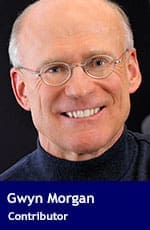 Mayor Gregor Robertson wants Vancouver to be “the world’s greenest city by 2020.” That’s a laudable goal, provided the path is rooted in sound science and economics, rather than a religious belief in a carbon-free heaven.
Mayor Gregor Robertson wants Vancouver to be “the world’s greenest city by 2020.” That’s a laudable goal, provided the path is rooted in sound science and economics, rather than a religious belief in a carbon-free heaven.
The first step, narrowing already-busy streets in favour of bike lanes, is infuriating drivers while their gridlocked cars increase exhaust emissions.
Now Robertson has raised the stakes from the world’s greenest city by 2020 to a “carbon-free city by 2050.” That means no fossil-fuelled vehicles, ships or, presumably, airplanes.
It also means replacing all natural gas-fuelled heating and industrial processes with electricity.
That would require an extremely costly retrofitting of houses, offices and other commercial buildings. Then there are the operating costs. Even at today’s low electricity rates, the Canadian Taxpayers Federation estimates that switching to electricity would cost the average family $1,400 more a year in energy bills. And that doesn’t include the cost of ripping out and replacing furnaces and water heaters.
The source of all that additional electricity? Wind and solar, according to Robertson’s vision.
But look at Ontario. Contracts priced at multiples of exiting rates enriched solar and wind power companies while driving that province from one of North America’s lowest electricity cost jurisdictions to a job-killing highest.
It’s ironic that Vancouver city council wants to ban natural gas – by far the cleanest and lowest-emission fossil fuel – as its first step towards carbon-free nirvana.
But even if the people of Vancouver are forced down this path, what difference would it make to global emissions?
Over the last 15 years, global carbon emissions have grown at the rate of 1,125 megatonnes a year, or 3.1 megatonnes a day. Vancouver’s natural gas emissions are 1.5 megatonnes a year. So global growth would overcome that tiny emissions reduction in less than half a day.
This policy amply qualifies Robertson as charter member of the Canadian Misguided Mayors Club.
The search for other club candidates takes us immediately to Montreal, where Mayor Denis Coderre has insisted the Energy East oil pipeline be blocked from passing through Quebec, citing “environmental threats and too few economic benefits.”
This is baffling for several reasons.
First, construction of the pipeline is expected to increase Quebec’s gross domestic product by $3 billion, create 4,000 jobs and generate $700 million in annual tax revenue.
Second, the pipeline would replace tankers carrying oil up the St. Lawrence Seaway to the Port of Montreal with oil transported by what should be one of the world’s safest state-of-the-art pipelines.
Third, Canadian oil delivered through the pipeline would eliminate Eastern Canada’s dependency on crude from such models of democracy and human rights as Algeria, Angola, Iran, Libya and other states in the Middle Eastern/North African hotbed of conflict.
Given these facts, it’s astounding that Coderre shows up for those frantic demonstrations against Energy East.
And there’s another factor that should have all Quebecers very worried. In the 2016-17 fiscal year, Quebec will receive $10 billion under the federal equalization program. The formula is quite complex but it starts by averaging the per capita “fiscal capacity” (closely related to GDP) of all 10 provinces. Those with a fiscal capacity below the average, the “have-not provinces,” receive equalization grants.
The federal government relies on the higher tax revenues from provinces with above-average fiscal capacity (have provinces) to help fund the grants. In recent years, the only have provinces were B.C. and the three oil producers, Alberta, Saskatchewan and Newfoundland. But now, the fiscal capacity of the oil-producing provinces has dropped dramatically.
Lack of pipeline access to world markets is forcing Canadian producers to sell their oil for some $15 billion a year below the world price. And without new pipeline capacity, capital investment has collapsed, throwing more than 100,000 people out of work.
The fiscal capacity of the oil-producing provinces is dropping dramatically and taking the provincial average with it. When the latest calculation is revealed, the average will be much closer to Quebec’s number, reducing or eliminating that province’s $10-billion grant.
The full impact will be delayed because the equalization formula works on a three-year rolling average. But in a province with a debt/GDP ratio already the highest of any province, Coderre would be wise to become one of Energy East’s most ardent supporters.
That also means not tilting at energy-generating windmills, as Vancouver’s Robertson has so wistfully done.
Gwyn Morgan is a retired Canadian business leader who has been a director of five global corporations.
Gwyn is a Troy Media contributor. Why aren’t you?
The views, opinions and positions expressed by columnists and contributors are the author’s alone. They do not inherently or expressly reflect the views, opinions and/or positions of our publication.


